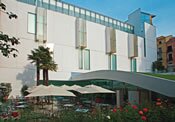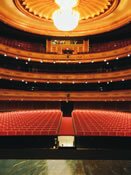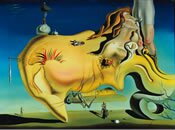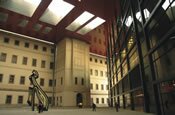Inflight Magazine of Brussels Airlines
Welcome to the Inflight Magazine of Brussels Airlines
A cultural capital
 By visiting three museums all within walking distance of each other in Madrid, you can explore artworks from the 12th century to the modern day, as Adrian Mourby discovers
By visiting three museums all within walking distance of each other in Madrid, you can explore artworks from the 12th century to the modern day, as Adrian Mourby discovers
As Spain’s capital since 1561, Madrid has enjoyed a long and varied cultural history. Nowhere is this better seen than in the city’s golden triangle of art galleries – Museo Nacional del Prado, Museo ThyssenBornemisza and Museo Nacional Centro de Arte Reina Sofía. All three are located just a few minutes’ walk from each other in the city’s historic centre and combine to make this one of the great cultural destinations in Europe.
As well as these fabulous galleries, there are also two historic performance venues nearby. The famous Teatro de la Zarzuela is only a few streets away from Thyssen-Bornemisza, while Teatro Royal is one of the world’s greatest opera houses.
Museo Nacional del Prado
 Paseo del Prado ,www.museodelprado.es The world-famous Prado was built in the 18th century so Carlos III could display the royal family’s collection of art. It occupied a section of land that had previously been a meadow – or prado – and the curious name stuck.
Paseo del Prado ,www.museodelprado.es The world-famous Prado was built in the 18th century so Carlos III could display the royal family’s collection of art. It occupied a section of land that had previously been a meadow – or prado – and the curious name stuck.
New exhibitions
During Napoleon’s occupation of Spain, the Prado was used as a three hours respectively – to take visitors past the highlights. The one-hour route contains Diego Velázquez’s Las Meninas (also known as The Family of Felipe IV) and Francisco Goya’s famous firing squad painting El Tres de Mayo de 1808 en Madrid, as well as masterpieces by Fra Angelico, Titian and Albrecht Dürer.
New exhibitions Joaquín Sorolla (1863-1923), until 6 September Valencia-born Sorolla was Spain’s most celebrated 19th-century artist. This exhibition assembles 100 canvases, including Return from Fishing (1894), on loan from Musée d’Orsay in Paris; Sewing the Sail (1896), from Galleria Internazionale d’Arte Moderna di Ca’Pesaro in Venice; and Afternoon Sun (1903) from the Hispanic Society of America in New York.
View and Plan of Toledo by El Greco, until 1 November
The great El Greco painted partial views of Toledo into a number of his pictures, but his View and Plan of Toledo offers a detailed plan of the city he called home for almost 40 years. Pure landscapes were a rarity in El Greco’s work; this is on loan from Museo del Greco in Toledo.
Museo Thyssen-Bornemisza
Palacio de Villahermosa, 8 Paseo del Prado, museothyssen.org Opposite the Prado stands an 18th-century building built as a palace, which then served as a bank before being taken over to house two hugely important collections of paintings.
In 1993, the Spanish government acquired the art collection of Baron Hans Heinrich Thyssen-Bornemisza and in 2004 it borrowed the collection of his widow, Carmen. Together, these collections form one of the largest private art galleries in the world.
Klee and Edward Hopper. The gallery’s collection of 19th-century North American paintings is unique in Europe.
Elsewhere in Madrid
Other cultural institutions to visit
 Teatro Real Plaza Isabel II s/n, teatro-real.com Madrid’s royal theatre (known locally as El Real) is located in front of Palacio Real, once the official residence of Isabel II, who ordered its construction in 1850. Giuseppe Verdi premiered his La Forza del Destino at the theatre in 1863 and in 1925 Vaslav Nijinsky danced here with the Ballets Russes.
Teatro Real Plaza Isabel II s/n, teatro-real.com Madrid’s royal theatre (known locally as El Real) is located in front of Palacio Real, once the official residence of Isabel II, who ordered its construction in 1850. Giuseppe Verdi premiered his La Forza del Destino at the theatre in 1863 and in 1925 Vaslav Nijinsky danced here with the Ballets Russes.
The 2009-2010 season opens on 28 September with Alban Berg’s opera Lulu (until 16 October), followed by a concert version of Georg Friedrich Handel’s Theodora by the Gabrieli Consort.
Teatro de la Zarzuela
4 Calle Jovellanos,
teatrodelazarzuela.mcu.es
Zarzuela, Spain’s home-grown form of operetta, got its own venue in 1856 with the construction of this famous 1,100-seat venue. This melodramatic form of music-drama remains highly popular with Spanish audiences, but the theatre also stages dance performances, sometimes by Ballet Nacional de España.
The 2009-2010 season begins with La Tabernera del Puerto, a nautical romance from 1936 by Pablo Sorozábal, which runs from 16 October until 8 November.
 New exhibitions
New exhibitions
Matisse 1917-1941, until 20 September
True to its pan-European roots, this summer Museo Thyssen-Bornemisza focuses on a non-Spanish painter. In 1917, Henri Matisse moved to the French Riviera and, in the shadow of two world wars, developed some of his most individual and distinctive works.
Museo Nacional Centro de Arte Reina Sofía
52 Calle Santa Isabel,
museoreinasofia.es
This four-storey building near Atocha station is just 10 minutes’ walk from the Prado. Built in the 18th century as a hospital, it was turned into Madrid’s combined equivalent of London’s Tate Britain and Tate Modern in 1992.
 The museum is mainly dedicated to more recent Spanish art. Highlights include Pablo Picasso’s Guernica and works by Salvador Dalí, Juan Gris and Joan Miró, but there are also works by Henry Moore, Francis Bacon, Mark Rothko and Cy Twombly.
The museum is mainly dedicated to more recent Spanish art. Highlights include Pablo Picasso’s Guernica and works by Salvador Dalí, Juan Gris and Joan Miró, but there are also works by Henry Moore, Francis Bacon, Mark Rothko and Cy Twombly.
New exhibitions
Juan Muñoz Retrospective, until 31 August
This collection of life sculptures by Muñoz spills out of the museum into Jardines de Sabatini. After receiving Spain’s National Plastic Arts Award in 2000, Muñoz became the first Spanish artist invited to exhibit in Tate Modern’s Turbine Hall in June 2001. He died two months later, at the height of his career.
 The Esquizos of Madrid, until 14 September
The Esquizos of Madrid, until 14 September
This exhibition concentrates on modernist figurative painting from Spain between 1970 and 1985, during the country’s growth of democracy. The 10 artists featured have been chosen for the way in which their work challenged both the accepted aesthetic conventions and the political orthodoxy that were the legacy of Franco’s Spain.
David Maljkovich, 9 September until January 2010
Croatian artist Maljkovich uses video, paintings and found objects to illustrate his country’s shift from communism to capitalism, and the various acts of collective memory (and amnesia) that accompanied this transition.
FR Une capitale culturelle
En visitant trois musées à Madrid, très proches les uns des autres, vous pourrez explorer plusieurs siècles d’histoire de l’art. Adrian Mourby nous fait découvrir ces collections d’œuvres uniques du XIIème siècle jusqu’à l’époque contemporaine.
Madrid connaît une longue histoire de ville culturelle. Sa richesse artistique accumulée au cours des siècles transparaît particulièrement dans le triangle d’or de ses institutions muséales.
Le Musée National du Prado (museodelprado. es) a été construit au XVIIIème siècle pour abriter la collection de peintures de la famille royale. Aujourd’hui, il recense l’une des plus importantes collections d’art européen, allant du XIIème au début du XIXème siècle, dont Las Meninas de Diego Velázquez et El Tres de Mayo de 1808 en Madrid de Francisco Goya. Jusqu’au 6 septembre, vous pourrez y voir l’exposition Joaquín Sorolla (1863-1923), un hommage à l’artiste le plus célèbre du XIXème siècle en Espagne, tandis que View and Plan of Toledo par El Greco est également à l’affiche jusqu’au 1er novembre.
De l’autre côté du Prado, le Musée ThyssenBornemisza (museothyssen.org) rassemble deux collections privées. La collection permanente se compose de pièces allant du XIIIème siècle, avec des toiles de primitifs italiens et flamands, jusqu’à Vincent Van Gogh et Piet Mondrian. L’exposition Matisse 1917-1941 est en cours jusqu’au 20 septembre.
Le troisième musée faisant partie du triangle, le Musée National Centro de Arte Reina Sofía (museoreinasofia.es), est principalement dédié à l’art espagnol plus récent, dont le célèbre Guernica de Pablo Picasso et des œuvres de Salvador Dalí, Juan Gris et Joan Miró. Les expositions actuelles incluent une Rétrospective de Juan Muñoz jusqu’au 31 août, The Esquizos of Madrid jusqu’au 14 septembre, et David Maljkovich du 9 septembre à janvier 2010.
D’autres lieux artistiques de Madrid méritent aussi le détour, dont le Teatro Real (teatro-real. com). Sa saison 2009-2010 s’ouvre le 28 septembre avec l’opéra d’Alban Berg Lulu. Le Teatro de la Zarzuela (teatrodelazarzuela.mcu.es) présente une forme d’opérette très prisée des Espagnols ainsi que des spectacles de danse. La saison 2009-2010 commence avec La Tabernera del Puerto de Pablo Sorozábal le 16 octobre.
NL Een hoofdstad vol cultuur
In Madrid kan je, op wandelafstand van elkaar, in drie musea kunstwerken bewonderen van de 12e eeuw tot nu. Adrian Mourby duikt in een cultureel bad
Madrid heeft een lange culturele geschiedenis. Dat merk je nergens beter dan in de gouden driehoek van kunstgalerijen in de stad.
Museo Nacional del Prado (museodelprado.es) werd gebouwd in de 18e eeuw om de schilderijencollectie van de Koninklijke familie tentoon te stellen. Vandaag is het een thuis voor een van de prachtigste collecties van Europese kunst van de 12e tot het begin van de 19e eeuw, met onder andere Las Meninas van Diego Velázquez en El Tres de Mayo de 1808 van Francisco Goya. Tot september kan je er de tentoonstelling Joaquín Sorolla (1863-1929) bewonderen, een eerbetoon aan Spanje’s meest gevierde 19e-eeuwse kunstenaar. Daarnaast loopt ook View and Plan of Toledo van El Greco tot 1 november.
Tegenover het Prado ligt Museo ThyssenBornemisza (museothyssen.org), een combinatie van twee private kunstcollecties. De permanente collecties bevatten 13e-eeuwse werken van Italiaanse en Vlaamse primitieven tot Vincent Van Gogh en Piet Mondriaan. De tentoonstelling Matisse 1917-1941 kan je er tot 20 september gaan bezichtigen.
Het derde museum van de driehoek is Museo Nacional Centro de Arte Reina Sofía (museoreinasofia.es). Dat is voornamelijk gewijd aan meer recente Spaanse kunst, met toppers als Pablo Picasso’s Guernica en werken van de hand van Salvador Dalí, Juan Gris en Joan Miró. Momenteel lopen er tentoonstellingen als Juan Muñoz Retrospective (tot 31 augustus), The Esquizos of Madrid (tot 14 september) en David Maljkovich (van 9 september tot januari 2010).
Ook liefhebbers van andere kunstvormen kunnen in Madrid hun hartje ophalen. Teatro Real (teatro-real.com) is zeker een bezoek waard. Het opent het seizoen 2009-2010 op 28 september met Alban Berg’s opera Lulu. Teatro de la
Zarzuela (teatrodelazarzuela.mcu.es) brengt typisch Spaanse melodramatische muziekdrama’s en dansvoorstellingen. Het seizoen 2009-2010 gaat op 16 oktober van start met La Tabernera del Puerto van Pablo Sorozábal.
Leave a Reply
